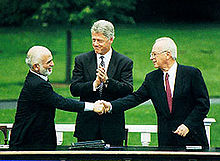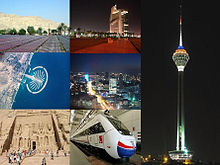- Middle East economic integration
-
Middle East economic integration has been envisioned, proposed or implemented by various parties in recent history.
The stated rationale is that peace, stability and prosperity in the Middle East can only be sustained over the long-run through intra-regional economic cooperation.[1]
Governance, education reform, social investing, knowledge economy, market economy, privatization and freedom of press are important ingredients in economic integration.[2]
Contents
Historical background
See also: History of the Middle EastAt the 1994 MIddle East and North Africa (MENA) conference in Casablanca, U.S. Secretary of State Warren Christopher stated that his government’s mission was to:[1]
Transform the peace being made between governments into a peace between peoples. Governments can make the peace. Governments can create the climate for economic growth. But only the people of the private sector can marshall [sic] the resources necessary for sustained growth and development. Only the private sector can produce a peace that will endure.
Objectives
See also: Economic integration and Tikkun olam A handshake between King Hussein I of Jordan and Israeli Prime Minister Yitzhak Rabin, accompanied by U.S. President Bill Clinton, during the Israel-Jordan peace negotiations, October 26, 1994
A handshake between King Hussein I of Jordan and Israeli Prime Minister Yitzhak Rabin, accompanied by U.S. President Bill Clinton, during the Israel-Jordan peace negotiations, October 26, 1994
We can identify three reasons why countries seek greater regional integration:
- to make economic welfare gains,
- to increase the region’s collective political bargaining power in extra-regional issues, and
- to achieve other non-economic national goals, such as meeting security concerns and preventing future conflict.
In 1993, one leading architect of the peace plan, Israeli Prime Minister Shimon Peres, envisioned that:[1]
The next stage, after bilateral and multilateral relationships have been established, will entail formation of regional industries through the cooperation of international bodies and independent international consortiums. At this point, the regional economic process will be upgraded and the new reality, in which business precedes politics, will be instituted. Ultimately, the Middle East will unite in a common market- after we achieve peace. And the very existence of this common market will foster vital interests in maintaining peace over the long term.
Economy and peace
See also: Oslo Peace Accord, US invasion of Iraq, Arab Peace Initiative, and Geneva AccordA prerequisite to economic integration is the establishment of peace in this region of the world. To date several initiatives have enabled a rapprochement between former political enemies:
The Oslo Peace Accords followed by the Israel–Jordan peace treaty in 1994 have promulgated a greater economic interaction between Israel and its Arab neighbors. Still, problems persist such as the Israeli–Palestinian conflict, also involving Syria, Lebanon and Iran. Furthermore, the instability created by the war in Afghanistan and the 2003 US invasion of Iraq are considered negative factors to be overcome before the establishment of an economic union in this region.
The regional characteristics of MENA
See also: Middle East and Economy of the Middle East- Despite many attempts since World War II to promote economic integration and political cooperation among states in the MENA region, economic interactions have remained limited. The scale of intra-regional merchandise trade is limited, amounting to only some 7-8% of total exports and imports; this compares to over 60% in the European.
Intra-regional trade, (% of total trade) EU CEE+CIS Asia Africa Middle East Western hemisphere Average (1991-97), source: International Monetary Fund 62.1 29.6 36.8 9.0 7.1 18.3 - Capital transactions have also been relatively limited, with the exception of large official flows from the oil-exporting economies to other Arab countries, particularly after the 1973–4 and 1979–80 oil-price increases. Financiers estimate that up to US$2 trillion in investable assets originate in the Persian Gulf region, the bulk of which is parked abroad, often as American Treasury bills and in places like Switzerland and London.[3] Increasingly, however, Arabs are investing in their home region. Governments are also spending billions of dollars on infrastructure, and national investment agencies are looking for opportunities.
- Tourism and other non-factor service-flow patterns have been quite segmented. Some countries—primarily Egypt, Jordan, Lebanon, Morocco and Tunisia—have received substantial tourist flows from within Mena. For others, particularly Israel, regional tourism has been inhibited by political and security considerations.
- Labour flows have been important, taking the form of:
- Flows from non-oil economies to the GCC economies, and
- Palestinian labour working in Israel. In the 1990s, these flows have been subject to major restrictions and there has been recent substitution of Asian labour for Arab labour in both cases. Mena does not have the kind of labour mobility found, for example, in the EU, where the citizens of one country have the right to work in others.
- There has been little in the way of regional economic policy coordination, except for the GCC and through the OPEC mechanism.
Prospects for the MENA Region[4] MENA Region 2009 2010 2011 Real GDP growth 2.8 3.6 4.5 Real GDP growth (PPP) 2.7 3.6 4.5 Exports (change %) -9.5 2.6 5.2 Imports (change %) 1.2 4.9 6.6 CA (% of GDP) -0.1 1.5 0.9 Projects
See also: Economy of the Middle East and Foreign Direct InvestmentAmong the main concrete projects that have been initiated towards economic integration in the Middle East, one can mention:
- Council of Arab Economic Unity: Established in 1964, with the ultimate goal of achieving complete economic unity among its member states. An intermediate objective of customs union has been set for 2015.[5]
- Economic Cooperation Organization: Established in 1985. The common objective is to establish a single market for goods and services in West Asia, like the European Union.
- US-Middle East Free Trade Area: The U.S. objective with this 2003-initiative has been to gradually increase trade and investment in the Middle East, and to assist the Middle East countries in implementing domestic reforms, instituting the rule of law, protecting private property rights (including intellectual property), and creating a foundation for openness, economic growth, and prosperity.
- Euro-Mediterranean free trade area: The initial aim is to create a matrix of Free Trade Agreements between each of the partners and the others. Then a single free trade area of 600-800 million people is to be formed, including the European Union.
Challenges and opportunities
See also: Transition economy and WTO accession and membershipThere are many obstacles to investment in the region, both real and perceived:
- Governance: Capital is attracted to environments where the rules of the game are clear, adhered to by all and enforced. Some Middle East countries have made positive steps forward in some areas such as reforming their judicial systems or adapting their capital market laws to international standards such as Saudi Arabia. However, as a whole good governance is unevenly spread across the region, therefore building efficient and capable public institutions is one priority.
- Raise competitiveness levels of these economies. This can be achieved through overhauling and aggressively investing in the region’s education system. If the education policies of the region deliver unwanted skills to the market, international investors will not be keen to come in, especially in the services sector. Unemployment runs as high as 40% in at least seven Arab nations.[5] Social investing should be planned in order to produce more entrepreneurs, engineers, scientists, and MBA graduates and expand the middle class.
- Raising competitiveness also entails accelerating the privatization programs, trade liberalization, investing in the infrastructure, deepening and linking capital markets and ensuring that business tackles corruption with a passion.
- Facilitate the usage and penetration of new technologies. This would enhance the free flow of ideas, information and harness the forces of entrepreneurship. New technologies spur innovation and increase productivity which investors seek.
- Linked to this is increasing the freedom of the press and media which provides checks and balances against governments and business. New technology and freedom of the press would have a particular impact on youth and would encourage participation in the definition of future strategies at national and regional levels. Inter-Middle East cooperation would be enhanced and global integration into the knowledge economy would be achieved. Increasing the use of new technologies would also reduce red tape and bureaucratic hurdles which are often quoted by business leaders as deterrents to investment.
See also
- Arab Maghreb Union
- Cooperation Council for the Arab States of the Gulf
- Economy of the Organisation of the Islamic Conference
- Mediterranean Union
- African Economic Community
- Arab Cooperation Council
- List of free trade agreements
- List of Trade blocs
- South-South Cooperation
- Middle East and globalization
External links
- MENA Report
- Trade policy and economic integration in the Middle East and North Africa By Hassan Hakimian, Jeffrey B. Nugent (2001)
- Globalisation and economic integration among Arab countries (1998)
- The "new Middle East" from the prespective of the old Middle East
- Vali Nasr - Rise of Muslim Middle Class
- 2010 Economic Prospects for the Middle East and North Africa Region - World Bank
- Videos
- Middle East Today: The Economic situation in the Arab World (Free PressTV documentary)
References
- ^ a b c http://www.arts.uwaterloo.ca/~bmomani/WE-%20MEFTA.pdf
- ^ http://www.middleeastconversation.org/?p=1749
- ^ http://www.middleeastconversation.org/?p=1749
- ^ http://www.payvand.com/news/10/jan/1220.html
- ^ a b "Business Articles - Arabs urged to speed up economic integration". The Daily Star. 2010-02-12. http://www.dailystar.com.lb/article.asp?edition_id=10&categ_id=3&article_id=111673. Retrieved 2010-02-25.
Categories:- Middle East
- Economy of the Middle East
- Middle East peace efforts
Wikimedia Foundation. 2010.


